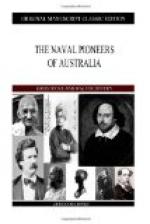After Hunter, senior, was shipwrecked, John was sent to his uncle, a merchant of Lynn, who sent the boy to school, where he became acquainted with Charles Burney, the musician. Dr. Burney wanted to make a musician of him, and Hunter was nothing loth, but the uncle intended the boy for the Church, and sent him to the Aberdeen University. There his thoughts once more turned to the sea, and he was duly entered in the Grampus as captain’s servant in 1754, which of course means that he was so rated on the books in the fashion of the time. After obtaining his rating as A.B., and then as midshipman, he passed his examination as lieutenant in February, 1760; but it was not until twenty [Sidenote: 1760] years later, when he was forty-three, that he received his lieutenant’s commission, having in the interval served in pretty well every quarter of the globe as midshipman and master’s mate. In 1757 he was under Sir Charles Knowles in the expedition against Rochefort; in 1759 he served under Sir Charles Saunders at Quebec; in 1756 he was master of the Eagle, Lord Howe’s flagship, so skilfully navigating the vessel up the Delaware and Chesapeake and in the defence of Sandy Hook that Lord Howe recommended him for promotion in these words:—
“Mr. John Hunter, from
his knowledge and experience in all the
branches of his profession,
is justly entitled to the character of
a distinguished officer.”
It was some years, however, before Hunter was given a chance, which came to him when serving in the West Indies, under Sir George Rodney, who appointed him a lieutenant, and the appointment was confirmed by the Admiralty.
In 1782 he was again under Lord Howe as first lieutenant of the Victory, and soon after was given the command of the Marquis de Seignelay. Then came the Peace of Paris, and Hunter’s next appointment was to the Sirius. There is very little doubt from a study of the Naval Chronicle’s biographies and from the letters of Lord Howe that, if that nobleman had had his way, Hunter would have been the first governor of New South Wales, and it is equally likely that, if Hunter had been appointed to the chief command, the history of the expedition would have had to be written very differently, for brave and gallant as he was, he was a man without method.
When Phillip was appointed to govern the colonizing expedition and to command the Sirius, Hunter was posted as second captain of the frigate, in order that the ship, when Phillip assumed his shore duties, should be commanded by a post-captain. A few days after the arrival of the fleet Hunter set to work, and in the ship’s boats thoroughly surveyed Port Jackson. He was a keen explorer, and besides being one of the party who made the important discovery of the Hawkesbury river, he charted Botany and Broken Bays; and his charts as well as land maps, published in a capital book he wrote giving an account of the settlement, show how well he did the work.[C]




